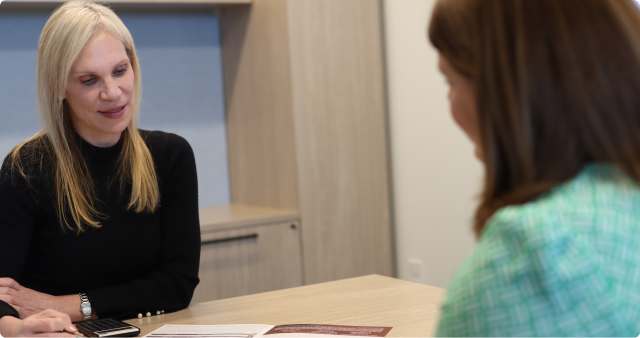Navigate the market’s recent swings, sparked by major tariff announcements and a significant stock sell-off. Examine the impact of balanced portfolios, learn why bonds are back in action, and explore how diversification might help you minimize losses during turbulent times.
Tariffs may create higher prices for consumers and small businesses, but could the new revenue pave the way for substantial tax cuts for both corporations and individuals? Unpack the potential silver lining in these challenging times.
Understand how the VIX (volatility index) behaves during major market shifts and why, historically, market performance tends to improve after sharp increases in volatility.
Despite the market ups and downs, Wes, Jeff, and Connor emphasize why staying balanced and diversified can be critical to your long-term investment strategy. Tune in for actionable strategies and work toward securing happiness in your financial future.
Read The Full Transcript From This Episode
(click below to expand and read the full interview)
- Wes Moss [00:00:02]:
The Q ratio, average convergence, divergence, basis points and BS Financial shows. Love to sound smart, but on Money Matters we want to make you smart. That’s why the goal is to keep you informed and empowered. Our focus Providing clear, actionable information without the financial jargon to help 1 million families retire sooner and happier, bigger. Based on the long running WSB radio show, this Money Matters podcast is tailor made for both modern retirees and those still in the planning stages. Join us in this exciting new chapter and let’s journey toward a financially secure and joyful retirement together. Welcome to Money Matters. It’s I would say it feels like a calm Sunday even after a crazy, crazy week in the stock market.Wes Moss [00:00:57]:
You you could not miss what happened Thursday, Friday, really, starting Wednesday night with tariff announcements out of the White House and the Rose Garden. The tariffs worse or bigger or stronger, however you want to look at it, than almost any economist or any Wall street bank expected. Hence the sell off that we saw really almost now, not across the board, but the big sell off we saw on Thursday in the stock market and Friday the equity markets. And I’m here on a Sunday morning along with our team, which I’ll bring in in just a second to just sift through what’s happening, try to understand really what the whole purpose behind these tariffs are. It’s really about a trade imbalance that Washington is very focused on and wants to try to remedy or fix. There’s an awful lot of cost that comes into doing so, and that’s what we’ve been seeing really since mid February. But the crescendo, at least so far, and the waterfall decline that we saw in the last two days, or not last two days, but last two days of the week, obviously that gets everyone’s attention. So I do think that there’s some silver linings here and I do think that there is a way out of this.Wes Moss [00:02:09]:
Every single time there is a big decline. We can go back to the scary dark days of COVID when The market fell 30 plus percent in a month. We go back to the very complicated and scary days of 2007, 8 and early 09. Didn’t seem like there was a way out of it didn’t seem like there was a way out of how are we going to how’s the stock market going to Recover Sitting here five years ago in March of 2020 when the whole global economy was completely shut down Here we’re talking about raising prices on goods that we import from countries that already take advantage of us. And to me, I don’t see that there’s no way that we figure it, figure out our way through these other complicated periods of time and we don’t figure out our way, figure out a way to get through this. So I think today I just wanted to have some calmer heads and talk about the potential silver linings of what we’re seeing here and just how do we get go forward and what investors should be thinking about and what investors should be doing and that but we try to always do here. So in studio to me with today brought in the big guns because we did have a crazy week in markets, Connor Miller, chief investment strategist at Capital Investment Advisors and of course, Jeff Lloyd, who many of you know, if you’ve been listening to Money Matters for the past year, also in studio, gentlemen, welcome.Connor Miller [00:03:33]:
It’s good to be back. And yes, it was a week, so it is good to have the three of us in here this morning.Wes Moss [00:03:39]:
Feels good to be together.Jeff Lloyd [00:03:40]:
Nice to be able to digest this all together. I did want to bring up when you were talking about 2020 because that, that is the first parallel that we go to because it was chaotic. We had these big sell offs and back to back days. I think what we missed too is more recently 2022, we got a 25% sell off in stocks. And again, whenever you get these big declines, there is a lot of uncertainty attached to it. It never feels good. There’s no, there’s no such thing as a 15% pullback. That feels, that feels okay.Jeff Lloyd [00:04:12]:
Remember 2022, that was when everyone was calling for a recession. I, every economist on the earth was saying that the economy was certain to head into a recession. And I think because the equity markets did so well in 2023 and 2024, we kind of lose sight of that a little bit. But just adding another analog to this, adding some perspective to the conversation I think helps.Wes Moss [00:04:34]:
Yeah. And I noticed myself when you’re looking at a screen or you’re looking at financial news and I do probably an unhealthily large way all the time, it seems even in my car when I’m going to and fro, I am listening to CNBC or Bloomberg to see what’s going on pretty much at all times, try not to do it as much on the weekend, but certainly throughout the week. And Jeff Lloyd, it’s good to just kind of talk through and I know throughout this week it’s good that the three of us have been together a lot of this week and been able to just kind of process through just what’s happening because it’s not every day you get a 1500 point decline on Thursday in the Dow and down 2200 points on Friday. And that’s what we’re here to talk about here on the Sunday morning.Connor Miller [00:05:22]:
And there was a lot to process. There were nonstop tariff headlines. Dow down 1500 points, Nasdaq down 6%. You got oil markets selling off with OPEC increase in production and what that did to oil prices. We hadn’t even talked about it. We had the jobs number that came out on Friday.Wes Moss [00:05:42]:
It felt completely irrelevant, completely irrelevant.Connor Miller [00:05:46]:
So unemployment ticked up to 4.2% but we weren’t really focused on that. We were digesting all these other headlines and what that means for the economy and the markets moving forward.Wes Moss [00:05:55]:
We did add so March. And again, this is, this economic data is funny because you can have concurrent so real time data. You’ve got forward looking data and you got in the rear view mirror ancient data. And that’s what the jobs number kind of feels like is ancient backward looking data. That’s why it didn’t, I don’t have almost zero impact on markets, but we did add 228,000 jobs in March. That was better than the estimate that was for 140. So again, fundamentally, this economy, at least for now, that’s a good number. It’s a strong number.Wes Moss [00:06:26]:
Unemployment rates ticked up a tiny bit, but still 4.2% which is decidedly low on a historical basis. So the underlying fundamentals of this economy still have not started to really maybe as I think Connor, you’ve said, bend but not break. The US Consumer is kind of somewhat bending but not breaking. We’ll see where we go from here. But I think I wanted just to start with a perspective around what, what just what is the trade imbalance. And it seems as though one of the primary goals, of course of this administration and the tariffs of the fix. Quote fix. And again there’s, I’m not pretending to agree or disagree whether it’s broken or not because this has been an extraordinarily strong economy with us importing much more than we export around the world for many years now.Wes Moss [00:07:11]:
Lower prices overseas, hey, wait a minute, that’s cheaper to buy it over there. We’ll bring it in. And that’s what we have done now for decades in the United States that has really kept costs low. We buy more from the world than the world buys from us. There’s about a $1.2 trillion quote trade deficit which means that we buy, call it 3.2 trillion from outside the United States and other countries only buy about 2 trillion from us. Hence the $1.2 trillion trade deficit. For example, this is from last year. We imported, the United states imported about $440 billion from China, but only exported around 140 billion to China.Wes Moss [00:07:50]:
That’s again, that’s a deficit with China of about $300 billion. Same with the EU, the European Union. We have a trade deficit of about $250 billion. So again, we buy more from the world than the world buys from us. And that is the trade deficit and that is what tariffs here and according to this administration is trying to get a handle on trying to fix now. So there’s some other things as well. Now I also wanted to look at investment flows. So we’ve got all this money leaving our pocketbooks going to these other countries.Wes Moss [00:08:23]:
But at the same time, because America is still the quote, safest, most mature yet fast growing economy and most innovative economy. Talk about the army of America, America, productivity all the time on the globe to choose from. There’s significant money that still comes back into the United States. It doesn’t count as trade. It’s just the investment flows or financial accounting, if you will. So yes, we have this deficit in goods. It’s a very different picture when it comes to investment. So again, 2024 foreign investors poured about almost three quarters of a trillion dollars into the United States.Wes Moss [00:08:58]:
$750 billion of outside money from outside our shores coming into the United states to buy U.S. assets. Call it stocks, fixed income, bonds, direct investments. Same time Americans, we only put about $200 billion into foreign assets outside of our walls. That means we have about a 500, almost $550 billion positive flow of assets coming into the United States. More than went out. Half a billion dollar, half a trillion dollars more flowing in. That’s flowing.Wes Moss [00:09:32]:
So to some extent we buy more in goods, but people invest more here in the United States. Now if you start thinking about there’s been a ton of. Jeff, for you, I wanted to jump.Connor Miller [00:09:44]:
In here just talking about those investment flows with that amount of foreign money being poured into the United States system, that kind of speaks to the economic stability that globally investors have within the United States.Wes Moss [00:10:01]:
I can already hear listeners throwing things in their card. Well, not now. We’re not stable now. All we’re doing is creating uncertainty and chaos here in the United States. And there’s a point of no return because even if they lift the tariffs and this is still a negotiation which most people don’t believe anymore. I think that the world has now come to grips with, hey, these things are here to stay. Well, then you create even more uncertainty. How are companies supposed to build a factory in the United States which is going to, by the way, take three to five years before all these things that we want to be purchasing are even made here in the United States.Wes Moss [00:10:34]:
So again, I see both sides of this argument. What we’re trying to do here is just take stock of what has happened and what is happening. We don’t want to turn this obviously into a political conversation. This is an economic conversation because CEOs and business owners are sitting down and we’re sitting down this week. Think, okay, do I do, how do I adjust? How do I make my goods if they’re going to be tariffed? Connor, what’s the tariff on China now? 287%.Jeff Lloyd [00:11:04]:
You got to do a little bit of math. Now it’s the all in rate. Is could be up to 79%. So that you got to take the tariffs that were announced on Wednesday, 34% on top of the 25% announced in February, which is on top of the 20% that already existed from back in 20.Wes Moss [00:11:23]:
I can’t believe people can’t keep track of that. It’s funny. So you’ve got this layering and layering. And if a business owner is super dependent on China and their raw good is $100 coming from China. Now that raw good, well, it wouldn’t have been 100. If you go back many years, it was 100, then it was 120, then it was 150, and now it’s more like $179 from when it was several years ago. The other thing that I think came up a bunch this week, there’s been a lot of talk about the analog of wait a minute, didn’t we have all these tariffs back in the 30s, the Smoot Hawley tariffs, and then the economy went into this terrible period of time. Well, it’s very different of what the Federal Reserve did back then.Wes Moss [00:12:04]:
Back then, the Federal Reserve tightened monetary supply dramatically. They had already just raised interest rates from 4% to 14% because the stock market had already been, of course, the late 1920s. And the tax rate, Connor, went from.Jeff Lloyd [00:12:20]:
What, 20 low 20s all the way up north of 60%, the top effective or top marginal tax rate.Wes Moss [00:12:27]:
So we introduced these tariffs, we had 14% interest rates, we reduced the money supply and we quadrupled taxes. So think about that. So think about the Fed. The Fed is, is driving this economy back then I can only picture the Fed driving a car that would have been from the 1920s. Think about back then. They’re driving like a Model T and they’re kind of jalopying down the road. Today the Fed is much smarter than it was in the 1920s and the 1930s. Today I’ve envisioned them driving something like a multi amphibious cyber truck.Wes Moss [00:13:02]:
It’s a very different vehicle with levers that they can pull that they understand over the course of history the mistakes they made. And I just don’t see them doing that now. I also what we saw Jerome Powell on Friday and again I doubt he’s driving a cybertruck, but I did see on Friday that he is not ready to just lower rates tomorrow because of a stock market sell off. He’s not there to just come to the rescue because stocks sold off.Jeff Lloyd [00:13:31]:
And if you listen to it’s not even what he said, it’s when he said it. The very first comments that came out of his mouth were relating to inflation, saying that the announced tariffs would likely lead to higher prices. And so what does that mean? You have with the Fed, you have this dynamic between inflation and economic growth and employment. And so he was choosing to pay more attention to the inflation piece of it, which is an indication that they’re not ready to cut rates.Wes Moss [00:13:59]:
Speaking of, we’re talking about tax rates. The administration is saying, and again, you’re getting different numbers and different voices about what, what is the end goal here? Well, the end goal of course we are. We started the show with trying to reduce the trade deficit. Another big piece of this very well could be increased revenue here in the United States. So supposedly, and this is still yet to play out, these new tariffs would bring in 500 to 600 billion dollars in tariff tax revenue into the United States. That’s a huge amount of money that could be setting up. And this is where the silver lining comes in. That could be setting up a massive corporate tax cut and a massive individual tax cut.Wes Moss [00:14:45]:
Again, very opposite of what we saw in the 30s when we had the last massive trade war. So it’s setting up for that and I want to go into that a little further when we get back from break. Are you facing a fork in the road and deciding between continuing your career and retirement? I’m Wes Moss, host of Money Matters and this massive life decision shouldn’t be taken lightly. Talk with my team. If you’d like help reviewing your retirement accounts and building a financial plan, we can help you review options and offer an opinion based on your best interests. You can find us@yourwealth.com that’s y o u r wealth.com try to reset the table here on a Sunday morning break down what happened, what those announcements really were. Of course we know what the tariffs are supposed to be doing is trying to help with the trade deficit here in the United States. But of course markets did not like it one bit down 1500 points on Thursday and another 1500 points on Friday for the Dow.Wes Moss [00:15:50]:
So we’ve seen a really large market sell off. The one thing I will say because we’re I know that we’re focused in on the S&P 500, we’re focused in on the Nasdaq and the most popular names from the last couple of years, the Mag 7 have really taken it on the chin. Of course Tesla’s down further than that whole group. That’s for another variety of other reasons. But then you see the rest of the Mag 7 down pretty dramatically as well.Connor Miller [00:16:16]:
I think we saw this past week all of the Mag 7 names were down 20% from the previous highs or more at least all down 20.Wes Moss [00:16:24]:
But I think it’s important to note that the market is not the Nasdaq and not every one is invested 100% in the S&P 500. And it’s important to note and we spent a lot of time talking about this here on money matters of the power of diversification, the power of asset allocation, the power of having income and then segmenting your assets into various variety of buckets. I’m not that’s not a unique strategy. For as long as I’ve been in the world of investing, financial planning, investment planning we’ve thought of how do you segregate or bucketize if you will, aggressive assets, safety assets, etc. And safety assets did really well this week and bonds as an example behaved exactly how bonds are supposed to behave. When you have a stock market mini crisis and sell off, what happened? Well when money’s flown out of stocks like we saw this the last couple days of the week, it where did it go? It either went into cash or it went into fixed income. And what happens then? Well you’ve got the prices of fixed income went up because more people were trying to buy safety assets and interest rates went down. We saw the 10 year treasury go well below 4%.Wes Moss [00:17:43]:
So imagine having a diversified income portfolio and seeing the market down 5%. It doesn’t mean your portfolio should be not down unless you’re 100% in safety assets. And we know that doesn’t work well over time. It doesn’t combat inflation like we most Americans need it to do, but you do have a high degree of cushion and stability. Doesn’t mean again the overall pie isn’t down in a tough day like a Thursday and a tough day like a Friday for equities. But a diversified and balanced portfolio has been held up really well towards the end of the week and has held up really well so far in 2025. And I just think that’s important to note.Jeff Lloyd [00:18:28]:
Well and I think this was, I guess you could call it a warning that we gave a number of times on this show of highlighting the fact that The S&P 500 is meant to be a diversified product, but it got extremely concentrated over the last couple years. I think all the way up to 37% of the weight at one point came from its top 10 components. And just as properly diversified investors may not have experienced all of the return of the upside over the last couple years, they’re also probably holding up relatively well on the downside here.Wes Moss [00:19:02]:
Now I printed out this chart and this was later in the day on Friday and I still have it in front of me. But the sell off at the time and this was late on Friday. So here we are. The dow down about 15% from its all time high S&P 500 down over 17%. The NASDAQ down almost 23% and then one of the main dividend oriented all stock again dividend oriented stock ETFs that we look at all the time only down 11% again still negative, still down, not immune to this massive stock sell off that we saw. But those are some pretty big differences. There’s a big difference between down 10 and down 20 and that’s what we’re seeing. So not not only did safety assets stay stable during this the tail end of last week, but they rose and not all stocks got hit as much as primarily what we saw within technology.Wes Moss [00:20:01]:
So again, number one, diversified and balanced portfolios which a lot of Americans use. If you have a target date fund and you’re in close to retirement, your target date fund is likely very balanced. So it didn’t feel the entire drawdown or shock of the stock market.Jeff Lloyd [00:20:17]:
And that is something that we shouldn’t lose sight of either. Right. I think a huge takeaway with this is bonds are back. Remember 2022 when bonds fell almost as much as stocks and everyone was saying that the 60:40 balance portfolio was dead? Well, it’s not.Wes Moss [00:20:33]:
Well that was in our 2025 outlook. I think we said bonds are back.Jeff Lloyd [00:20:37]:
Bonds are back. Having balance in a portfolio makes sense.Connor Miller [00:20:42]:
Now we also did say volatility was back.Wes Moss [00:20:45]:
That’s an easy one to say Jeff as well. Speaking of that was an easier one to. But still we went a couple years.Connor Miller [00:20:54]:
We have seen over the last two years in 2023 and 2024 you found.Wes Moss [00:20:59]:
A great table slash chart, slash heat map. Late this week they actually looked at the vix. Take us through that again. The VIX is just the, call it the fear index, the fear measure in the, in the, for the market in general. The higher the vix, the more fear there is, the lower the vix, more complacency. So take us through what those findings look like.Connor Miller [00:21:21]:
Yeah, so the VIX basically stands for the volatility index. And certainly this past week we saw it spike to almost 40% which going back to, going back to 1990.Wes Moss [00:21:32]:
That’s, that’s the spiked 40% up to, up to 30.Connor Miller [00:21:37]:
Up to 30. But that percent gain was one of the highest on record. In fact it was 26 out of the, the highest 30. I’m looking at a chart that shows like the largest one day percent increase in the VIX. And what it looks at is what do market returns look like when the VIX spikes that much. And from, from what we can tell, markets are generally positive six months, one year, two year, three year, four and five years out. In fact, if you go, I know it’s a, it’s a longer term horizon but if you go out two, three, four and five years, the percent chance that you’re going to be higher is almost 100%.Wes Moss [00:22:23]:
Right. So the, I’m looking at this heat map here and it’s really almost as though if you’re looking a year out, Jeff Lloyd Every time we have seen the top 30 spikes in the Vix going higher. So anywhere from 35% higher. What we saw this past week, this was what from Thursday. So this was just the Thursday spike was almost 40% all the way up to 50% spikes that we saw in 2011. We saw 60% spikes in 2021. But if you go out a year later after you see the fear gauge rise and go up significantly precipitously, you go out a year later and the average of these periods and there’s 30 of them over the course of economic history, stocks are up 12%. Two years later, stocks are up 25%.Wes Moss [00:23:17]:
Again it makes sense because we, when fear is up, it means the markets are down and when do we want to buy or when do we want to not sell out? It’s when markets are down.Jeff Lloyd [00:23:26]:
And again, that doesn’t mean the volatility is over. If you look at the short term here, there, there is some red on the chart. But if you’re a long term investor like we advise being, the longer you go out, the more probability of success you’re going to have during these volatility spikes.Wes Moss [00:23:40]:
So number one, diversified income portfolios are working if you have a balance like so many. The default option in 401ks in America used to be money market many years ago over the last call of 10 to 15 years. The default option for a lot of plans, target date funds. You’re close to retirement and you pick target date fund that’s in a year coming up soon. It’s got a lot of balance and diversification in it. So the, the United States is not just invested in the Mag 7, God willing. Number two, the tariff announcements. Connor Miller, let’s just walk through again, the goal of them I think is twofold.Wes Moss [00:24:19]:
I don’t know if anybody knows the perfect answer to this. The one, the goal is to reduce the trade deficit too. It’s to raise revenue in the United States.Jeff Lloyd [00:24:28]:
Yeah. And one thing I think that was kind of up in the air was how much of the tariffs are being used as negotiation leverage, how much of them are here to stay. I think it became relatively clear, actually abundantly clear, that with this announcement last Wednesday, tariffs are here to stay. So let’s just walk through a little bit of the numbers here. Again, this is on top of what was announced on Canada and Mexico and China about a month or so ago. And so basically what was announced was a 10% broad based universal tariff on all imported goods that went into effect April 5th. And then there was an additional reciprocal tariff quote, unquote, reciprocal tariff on around 60 countries, which is anything beyond that 10% base rate. And so that was variable by country.Jeff Lloyd [00:25:16]:
Again, China had a different, was treated differently than the United Kingdom was and even differently than the European Union was.Wes Moss [00:25:25]:
It looks as though now as they stand, the Asian countries have the kind of the largest tariffs at this point. China 79%, Vietnam 46%, Japan I guess only at 24. But now let’s think about this. What are we trying to do besides have more Americans buy more American products? And you made a comment that the administration and President Trump, he looks at the US Consumer as what really the.Jeff Lloyd [00:25:56]:
Biggest prize to be won on the global stage of trade. I mean think of them, they are the we are the bell of us. Us, yeah, we are the bell of the ball. We are the richest country on earth and we buy an enormous amount of goods from other countries. And again, to your point on the trade deficit, I think the administration sees those dollars leaving the US and says, I think a lot of those dollars could stay here and benefit American workers.Wes Moss [00:26:25]:
Jeff Lloyd, silver lining could there be Is there any upside to this thing? Is there any upside to all of the carnage that we are seeing in equity markets?Connor Miller [00:26:38]:
I have to say this just with how the news has flown over the last couple weeks and days, it’s really too soon to say definitively. Okay. But yes, there could be some silver lining with the estimated 600 billion in new tariff revenue that could end up paving the way for some meaningful corporate tax cuts both for tax and individuals. Meaningful tax cuts both for individuals and corporations.Jeff Lloyd [00:27:03]:
And give us the context there for just how big that number is.Connor Miller [00:27:07]:
So 600. It’s 620 billion in potential tariff revenue coming in. That is more than the entire corporate income tax. Right now. The entire corporate income tax is about 500 billion. So this new revenue totally exceeds corporate income.Wes Moss [00:27:29]:
So again, it stands to reason, and again, we don’t know this because again, it’s not this can’t be done by executive order. This is something that Congress would have to do to do a tax package, do a corporate and favor corporations, favor individuals, which potentially could again offset the cost or the negative impacts for companies. Lower tax rate means what? Higher earnings, lower taxes for individuals. It means more money in our pocketbooks to go spend more in the US Economy. Really today, I think when you go through a week with a lot of turmoil markets, the dow was down 1500 points on Thursday and then down over 2000 points on Friday alone. Not to mention the other averages, the NASDAQ, the S&P 500 were down on a percentage basis, much more. We saw the Vix on Thursday go up 40%. On Friday it went up 50%.Wes Moss [00:28:25]:
So we’ve got a lot of fear and worry in the marketplace. And it’s just because a I don’t think people understand what’s happening with tariffs. We tried to kind of walk through that and explain that today. Again, the goal from what we could tell from the administration, is to try to have the United States solve the trade deficit. Again, we buy more from other countries than other countries buy from us and tariffs are supposed to close that gap, number one. Number two, the silver lining here could be that it raises 500 to 600 billion dollars in new revenue, which could then lead to really big tax cuts that we know this administration wants to do as well. Maybe most importantly, because we don’t know the exact answers right now to how this plays out is that diversification balance is really working for investors. It is not the kind of solution where you can go through a week where markets are down, call it 10% and everything’s fine and your portfolio is up because then you’d have to have a hundred percent cash or bond portfolio, which we also know over time doesn’t really work.Wes Moss [00:29:31]:
It doesn’t keep up with inflation. So what we all need to do, in my opinion, is to have a balance. Balance wins, balance investing. I think if the world were more balanced, it wouldn’t be a bad thing. So balance for investing and for investors helps a keep us involved in equity markets, which clearly can be difficult. And we saw the weeks like this, but over a long period of time outpace inflation with a real rate of return. Inflation’s 3. If we get 10, we have a real 7% rate of return and that’s how we stay ahead of the inflation curve.Wes Moss [00:30:10]:
Fixed income can at least usually match inflation. And it also provides a really nice balance. And it’s, it’s very appreciated if you had a balanced portfolio this week. So with that, we don’t have all the answers. I think, I don’t know if anybody does at this point of how this will play out over the next couple of weeks, months. But our focus and our horizon is always much longer than that. We’re investors, happy retirees, as a reminder, are tomorrow investors and so are we. Connor Miller, I really appreciate you being here on this Sunday morning.Jeff Lloyd [00:30:45]:
Thank you as always.Wes Moss [00:30:46]:
Jeff Lloyd, really appreciate your insights here on a Sunday morning. I love your VIX table heat map chart as well that you found this week.Connor Miller [00:30:54]:
It was good being back in the studio and being with the three of us, like we said this past week, really putting our heads together at the end of the week, trying to help the families that we serve digest all the news that they’ve been seeing on the headlines on the front page of the Wall Street Journal on cnbc. And just to give them our perspective on, yes, the market’s been volatile. We can’t time the top, we can’t time the bottom. Continue to stay invested and just a good reminder why we are balanced investors.Wes Moss [00:31:25]:
So with that, you could find Connor Miller, Jeff Lloyd, myself, easy to do so at your wealth. That’s why you are your wealth dot com. Have a wonderful rest of your day.Disclaimer [00:31:43]:
This is provided as a resource for informational purposes and is not to be viewed as investment advice or recommendations. This information is being presented without consideration of the investment objectives, risk tolerance, or financial circumstances of any specific investor and might not be suitable for all investors. The mention of any company is provided to you for informational purposes and an example only and is not to be considered investment advice or recommendation or an endorsement of any particular company. Past performance is not indicative of future results. Investing involves risk, including possible loss of principal. There is no guarantee offered that investment, return, yield or performance will be achieved. The information provided is strictly an opinion and for informational purposes only, and it is not known whether the strategies will be successful. There are many aspects and criteria that must be examined and considered before investing.Disclaimer [00:32:31]:
This information is not intended to and should not form a primary basis for any investment decision that you may make. Always consult your own legal tax or investment advisor before making any investment, tax, estate or financial planning considerations or decisions. Investment decisions should not be made solely based on information contained herein.
Call in with your financial questions for our team to answer: 800-805-6301
Join other happy retirees on our Retire Sooner Facebook Group: https://www.facebook.com/groups/retiresoonerpodcast
This information is provided to you as a resource for educational purposes and as an example only and is not to be considered investment advice or recommendation or an endorsement of any particular security. Investing involves risk, including the possible loss of principal. There is no guarantee offered that investment return, yield, or performance will be achieved. There will be periods of performance fluctuations, including periods of negative returns and periods where dividends will not be paid. Past performance is not indicative of future results when considering any investment vehicle. The mention of any specific security should not be inferred as having been successful or responsible for any investor achieving their investment goals. Additionally, the mention of any specific security is not to infer investment success of the security or of any portfolio. A reader may request a list of all recommendations made by Capital Investment Advisors within the immediately preceding period of one year upon written request to Capital Investment Advisors. It is not known whether any investor holding the mentioned securities have achieved their investment goals or experienced appreciation of their portfolio. This information is being presented without consideration of the investment objectives, risk tolerance, or financial circumstances of any specific investor and might not be suitable for all investors. This information is not intended to, and should not, form a primary basis for any investment decision that you may make. Always consult your own legal, tax, or investment advisor before making any investment/tax/estate/financial planning considerations or decisions.










